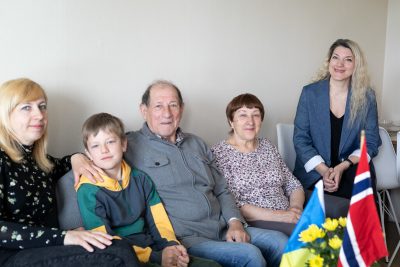The number of refugees arriving in Norway from Ukraine has risen sharply in the past six weeks, but they come at the cost of those from other countries. As thousands more seek asylum, the Norwegian government wants to once again cut the number of its so-called “quota refugees” transferred to Norway by the UN, this time in half.

The reduction emerged when Norway’s Labour-Center government presented its proposed state budget for next year late last week. Last year it cut its acceptance of UN-registered refugees, mostly from the Middle East and African countries, from 3,000 a year to 2,000. Now the government wants to accept only 1,000 through the UN quota system.
“A reduction of the quota would free up around NOK 164.7 million in 2024,” the government wrote in its budget proposal, and as much as NOK 3 billion during the three year period 2025 to 2028.
Newspaper Dagsavisen reported how the government justified its proposed cut in refugee acceptance on financial grounds. Money saved by not taking in more refugees from Afghanistan, for example, could then be used to help pay for the refugees already in Norway, according to the government. The vast majority of them are from Ukraine.
Norway’s immigration agency UDI (Utlendings direktoratet) reported that 62,936 Ukrainians had applied for and been granted asylum as of last week. They’ve been granted collective protection in Norway since Russia invaded Ukraine last year and their numbers continue to rise, by nearly another 500 as of Tuesday. That’s already twice the number of refugees who arrived during an influx, mostly from Syria and Afghanistan, in 2015 that prompted a crackdown by the Conservatives-led government at the time.
The Ukrainian refugees have seemed much more welcome, not least because of Norwegians’ ongoing support for the country under attack by Russia. Even the anti-immigration Progress Party has remained remarkably quiet as far more refugees arrive now than ever did during what Progress leader Sylvi Listhaug has referred to earlier as “refugee crises” led by “lykkejegere” (people seeking a better life instead of protection from persecution). People fleeing Ukraine have generally been granted asylum relatively quickly.

Norwegian Broadcasting (NRK) reported on Tuesday that Norway has also become a popular destination for many Ukrainians, not least because of the social services on offer. Oleh Bezdolnyi, a 60-year-old man from Zaporizjzja, now has an apartment in Bergen, financial support, medical care and the medicine he needs. He told state broadcaster NRK this week that he compared refugee programs around Europe before heading for Norway.
“I read about various European countries and saw many videos,” he said. “I chose Norway because there’s also security for people with health problems here. I’m very satisfied here.”
So are many others, with a record high 1,334 Ukrainians arriving i Norway last week alone. “We’ve seen a doubling of the number of refugees from Ukraine,” UDI director Frode Forfang told NRK. “Many came at the beginning of the war (in the winter and spring of 2022) but then the number stabilized after that.” After a steep decline in Ukrainian refugee arrivals in June 2022 and then the stable period, the numbers suddenly started to rise sharply in August.
That may be pegged to how Norway improved refugee programs that initially were criticized, and word has spread on social media. Many municipalities around the country, especially in outlying areas, have embraced the chance to attract new residents and the state support that come with them. Ukrainians are also widely viewed as facing fewer integration challenges than many other refugees.
Vilde Hernes, a senior researcher at Oslo Metropolitan University, said many other Ukrainians have also done their own research before deciding on a new homeland. She told NRK that they evaluate “their possibilities for learning the language, schools for their children and help to find a place to live. Many Ukrainians in Norway are very satisfied, and report back home on their experience.” Listhaug, the former minister who worked to fend off asylum seekers, did her best to crack down on such reporting and tried to spread the word instead that Norway was not a good country in which to seek asylum.
That’s not happening now, as Norway prepares to take in even more refugees from Ukraine but less from elsewhere. The new state budget proposals, though, were meeting protests from the Socialist Left Party (SV), on which the minority Labour-Center coalition relies for support.
“The cuts (in refugees from other countries) last year were bad enough,” Kaja Yngsdal Hilleren, international leader for SV’s youth organization, told Dagsavisen. “I can’t understand the logic, because even though Ukrainians need to flee, other refugees don’t suffer any less. The UN wants us to take in 5,000 quota refugees (not just 1,000) and we should agree to that.”
Political negotiations loom
SV had to concede the issue during budget negotiations last year, but is keen to argue for more refugees during upcoming budget negotiations this autumn. The party contends international solidarity is more important than ever. SV is particularly upset over another proposal that may tap into Norway’s foreign aid budget to help cover the costs of Ukrainian refugees in Norway.
“Finance Minister Trygve Slagsvold Vedum (of the Center Party) said in Parliament that we will support people in flight,” MP Kari Elisabeth Kaski of SV told Dagsavisen. “I don’t think the government is doing that to a sufficient degree.”
Nor do the organizations Redd Barna (Save the Children) and Kirkens Nødhjelp (Norwegian Church Aid), which note that the war in Ukraine has made the situation worse in other areas of the world. “Many countries are experiencing conflict and attacks, like Sudan,” wrote Norwegian Church Aid’s secretary general Dagfinn Høybråten in a press release. “There’s been a flood in Libya, economic collapse in Lebanon and enormous needs for help in Syria.” And that was before war broke out over the weekend between the militant Palestinian organization Hamas and Israel, where nearly 2 million Palestinians in Gaza were under attack this week.
NewsinEnglish.no/Nina Berglund

